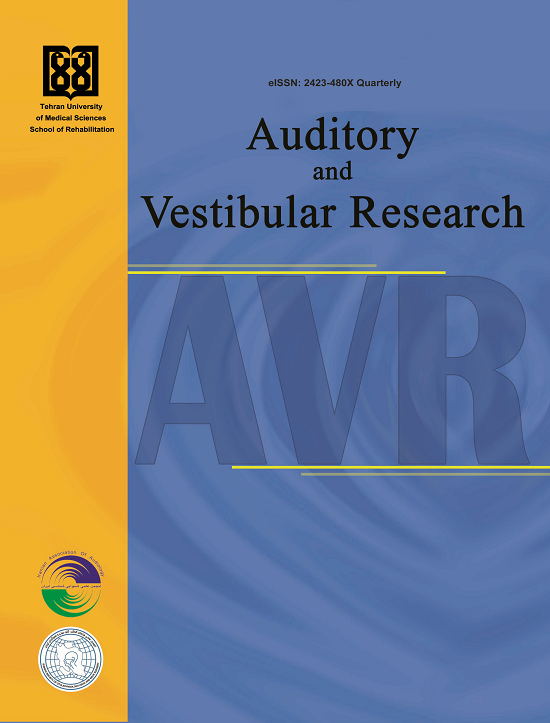Translation and assessment of the validity, reliability, sensitivity, and specificity of the Persian version of the dizziness symptom profile
Abstract
Background and Aim: Due to the annoying nature and prevalence of dizziness, vertigo, and imbalance, the need for rapid diagnosis, and challenges in the differential diagnosis of various vestibular disorders, this study aimed to translate the dizziness symptom profile (DSP), which is a self-report tool that helps clinicians differentiate the most common vestibular system disorders, into the Persian language and evaluate its validity, reliability, sensitivity, and specificity.
Methods: The profile was translated into Persian as DSP-P. Face, known-groups, and concurrent validities, internal consistency, test-retest reliability, sensitivity, and specificity were determined. 253 patients with dizziness and 59 healthy individuals completed the DSP-P before visiting the otolaryngologist, and the agreement between the proposed diagnoses of DSP-P and the final diagnosis of the otolaryngologist (our gold standard) was examined.
Results: The qualitative face validity of DSP-P was confirmed. There was a significant difference between the mean scores of the study groups (p < 0.001). The diagnosis of DSP-P was completely in agreement with the gold standard in 53.3% of cases. Internal consistency was excellent (α≥0.81) for all categories except the persistent postural-perceptual dizziness, superior canal dehiscence and unspecified unsteadiness categories (0.62≤α≤0.69). Generally, the test-retest reliability of the DSP-P scores and diagnoses was very good. The sensitivity of DSP-P was 94.4% for diagnosing benign paroxysmal positional vertigo, 93.5% for Meniere’s disease, 100% for vestibular neuritis, 86.3% for vestibular migraine, and 84.2% for persistent postural-perceptual dizziness.
Conclusions: The DSP-P was demonstrated to be a valid and reliable history-based diagnostic tool with high sensitivity and specificity.
2. Jacobson GP, Piker EG, Hatton K, Watford KE, Trone T, McCaslin DL, et al. Development and Preliminary Findings of the Dizziness Symptom Profile. Ear Hear. 2019;40(3):568-76. [DOI:10.1097/AUD.0000000000000628]
3. Hale T, Trahan H, Parent-Buck T. Evaluation of the patient with dizziness and balance disorders. In: Katz J, editor. Handbook of clinical audiology. 7th ed. Philadelphia, PA: Wolters Kluwer; 2015. p. 399-424.
4. Neuhauser HK. The epidemiology of dizziness and vertigo. Handb Clin Neurol. 2016;137:67-82. [DOI:10.1016/B978-0-444-63437-5.00005-4]
5. Al Saif A, Alsenany S. Sensitivity and specificity of the amer dizziness diagnostic scale (adds) for patients with vestibular disorders. J Phys Ther Sci. 2015;27(1):91-6. [DOI:10.1589/jpts.27.91]
6. Karatas M. Central vertigo and dizziness: epidemiology, differential diagnosis, and common causes. Neurologist. 2008;14(6):355-64. [DOI:10.1097/NRL.0b013e31817533a3]
7. Newman-Toker DE, Cannon LM, Stofferahn ME, Rothman RE, Hsieh YH, Zee DS. Imprecision in patient reports of dizziness symptom quality: a cross-sectional study conducted in an acute care setting. Mayo Clin Proc. 2007;82(11):1329-40. [DOI:10.4065/82.11.1329]
8. Hall DA, Zaragoza Domingo S, Hamdache LZ, Manchaiah V, Thammaiah S, Evans C, et al. A good practice guide for translating and adapting hearing-related questionnaires for different languages and cultures. Int J Audiol. 2018;57(3):161-75. [DOI:10.1080/14992027.2017.1393565]
9. Powell G, Derry-Sumner H, Rajenderkumar D, Rushton SK, Sumner P. Persistent postural perceptual dizziness is on a spectrum in the general population. Neurology. 2020;94(18):e1929-38. [DOI:10.1212/WNL.0000000000009373]
10. Revicki D. Internal Consistency Reliability. In: Michalos AC, editor. Encyclopedia of Quality of Life and Well-Being Research. Dordrecht: Springer; 2014. p. 3305-6.
11. Marx RG, Menezes A, Horovitz L, Jones EC, Warren RF. A comparison of two time intervals for test-retest reliability of health status instruments. J Clin Epidemiol. 2003;56(8):730-5. [DOI:10.1016/s0895-4356(03)00084-2]
12. Chua K, Gans R, Spinks S. Demographic and clinical characteristics of BPPV patients: a retrospective large cohort study of 1599 patients. J Otolaryngol ENT Res. 2020;12(1):20-30. [DOI:10.15406/joentr.2020.12.00451]
13. Roberts RA, Jacobson GP, Hatton K. Multiple Co-Occurring Vestibular Disorders Identified Using the Dizziness Symptom Profile. Am J Audiol. 2020;29(3):410-8. [DOI:10.1044/2020_AJA-19-00119]
14. Ishiyama A, Jacobson KM, Baloh RW. Migraine and benign positional vertigo. Ann Otol Rhinol Laryngol. 2000;109(4):377-80. [DOI:10.1177/000348940010900407]
15. Lempert T, Olesen J, Furman J, Waterston J, Seemungal B, Carey J, et al. Vestibular migraine: Diagnostic criteria1. J Vestib Res. 2022;32(1):1-6. [DOI:10.3233/VES-201644]
16. Chu CH, Liu CJ, Lin LY, Chen TJ, Wang SJ. Migraine is associated with an increased risk for benign paroxysmal positional vertigo: a nationwide population-based study. J Headache Pain. 2015;16:62. [DOI:10.1186/s10194-015-0547-z]
17. Beh SC, Masrour S, Smith SV, Friedman DI. The Spectrum of Vestibular Migraine: Clinical Features, Triggers, and Examination Findings. Headache. 2019;59(5):727-40. [DOI:10.1111/head.13484]
18. Huang TC, Wang SJ, Kheradmand A. Vestibular migraine: An update on current understanding and future directions. Cephalalgia. 2020;40(1):107-21. [DOI:10.1177/0333102419869317]
19. Popkirov S, Staab JP, Stone J. Persistent postural-perceptual dizziness (PPPD): a common, characteristic and treatable cause of chronic dizziness. Pract Neurol. 2018;18(1):5-13. [DOI:10.1136/practneurol-2017-001809]
20. Zhao JG, Piccirillo JF, Spitznagel EL Jr, Kallogjeri D, Goebel JA. Predictive capability of historical data for diagnosis of dizziness. Otol Neurotol. 2011;32(2):284-90. [DOI:10.1097/MAO.0b013e318204aad3]
21. Filippopulos FM, Strobl R, Belanovic B, Dunker K, Grill E, Brandt T, et al. Validation of a comprehensive diagnostic algorithm for patients with acute vertigo and dizziness. Eur J Neurol. 2022;29(10):3092-101. [DOI:10.1111/ene.15448]
22. Suvanich R, Chatchawan U, Jariengprasert C, Yimtae K, Hunsawong T, Emasithi A. Development and validation of the dizziness symptoms questionnaire in Thai-outpatients. Braz J Otorhinolaryngol. 2022;88(5):780-6. [DOI:10.1016/j.bjorl.2021.05.007]
23. Landon-Lane RL, Piker EG, Jacobson GP, Hatton K, Roberts RA. Test-Retest Reliability of the Dizziness Symptom Profile. Ear Hear. 2021;42(1):206-13. [DOI:10.1097/AUD.0000000000000918]
| Files | ||
| Issue | Articles in Press | |
| Section | Research Article(s) | |
| Keywords | ||
| Vertigo validity reliability dizziness symptom profile | ||
| Rights and permissions | |

|
This work is licensed under a Creative Commons Attribution-NonCommercial 4.0 International License. |






